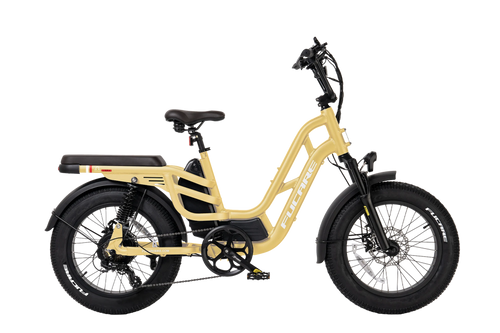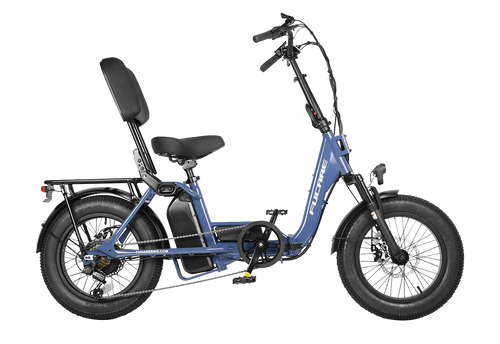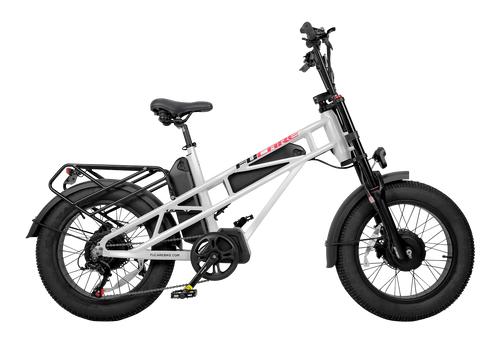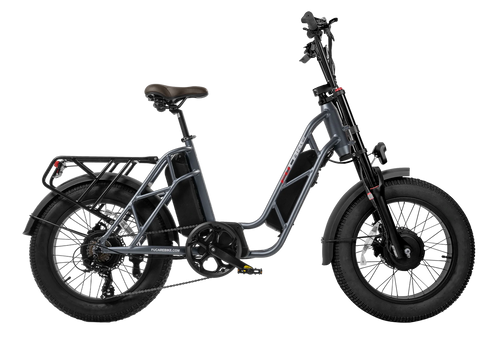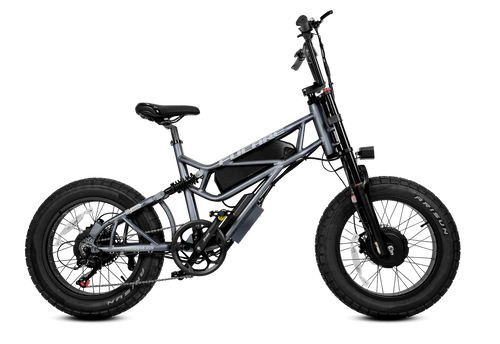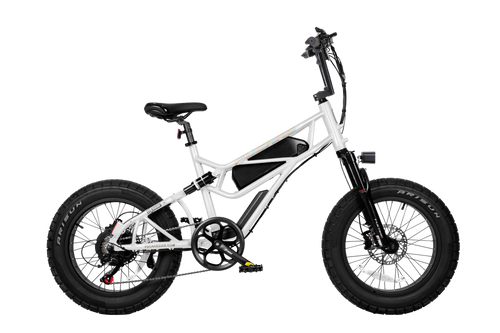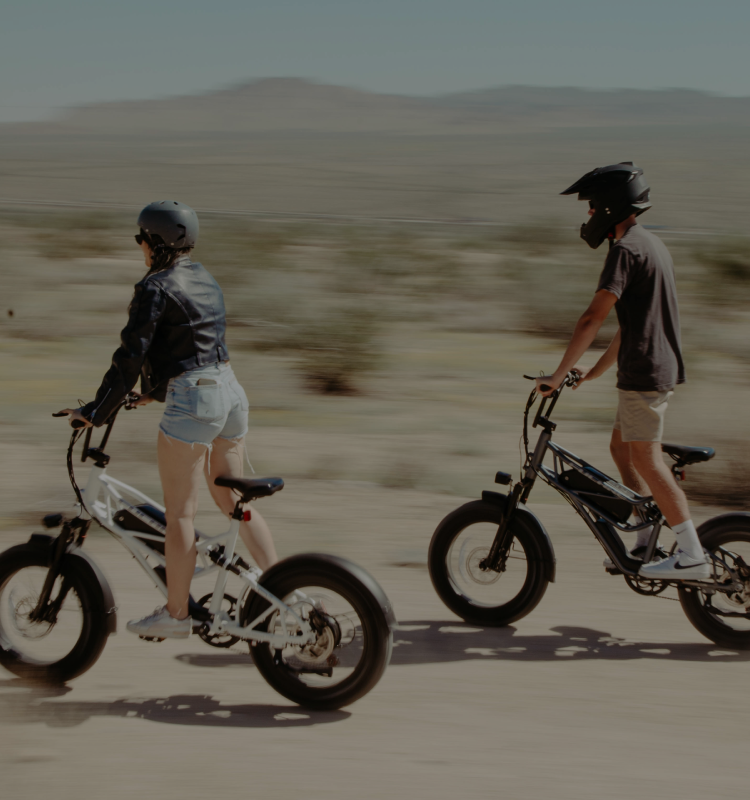E-bikes 101: Gear Up for Electric Riding
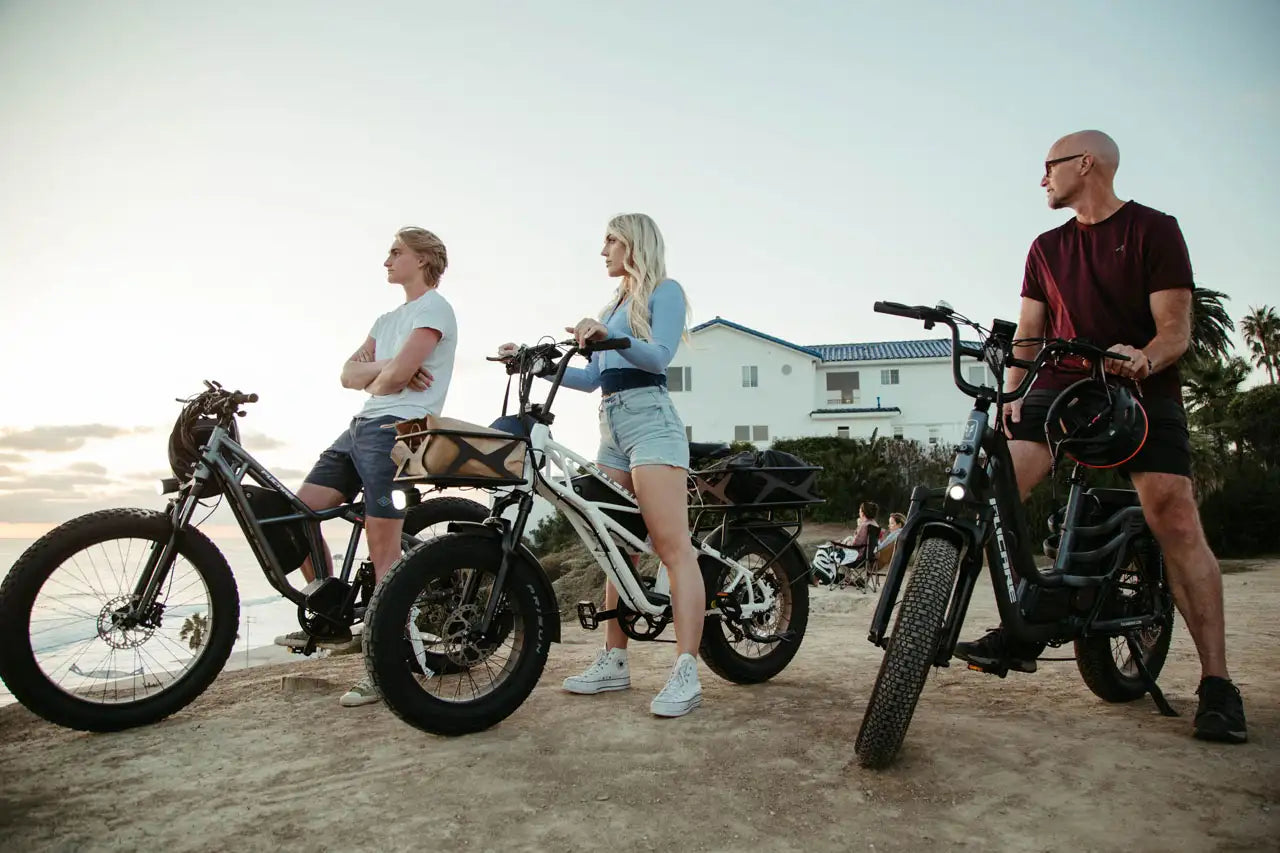
Electric bikes are rapidly transforming the cycling landscape. They offer a powerful and eco-friendly way to travel, opening up cycling to a wider range of people.
Revved up about joining the e-bike revolution? You're not alone! This comprehensive buyer's guide is designed to be your one-stop shop for everything you need to know about selecting and owning an e-bike.
In this guide to e-bikes, we'll break down everything you need to know – from the nuts and bolts of how e-bikes work to the exciting world of e-bike styles – to help you find the perfect electric fit. Buckle up and get ready to ride!
- Chapter 1: What is an E-Bike and How Does it Work?
- Chapter 2: Different Types of Electric Bikes
- Chapter 3: Different Classes of E-Bikes
- Electric Bike Regulations
- Can You Ride an Electric Bike on the Sidewalk?
- What Age Can You Ride an Electric Bike?
- Chapter 4: What Do You Look For When Buying An E-bike?
- Chapter 5: Electric Bikes for Fitness and Health
Chapter 1: What is an E-Bike and How Does it Work?

E-bikes are like bikes with superpowers! They offer a thrilling electric motor that acts like a personal wind turbine, giving you a boost up hills and on long rides. Unlike mopeds or motorcycles, e-bikes are whisper quiet and eco-friendly, leaving no emissions behind.
The beauty of e-bikes is their variety. Just like regular bikes, there's an e-bike for every rider and every ride. Whether you're after a fashion commuter to conquer your daily grind or a beastly off-road machine to tame tough terrain, there's an e-bike perfectly suited to your two-wheeled adventures.
How Do Electric Bikes Work?
E-bikes work in the same way as regular bikes with a hidden helper: an electric motor! The motor gives you a boost when you pedal, making hills and wind a breeze. It can be in the front wheel, rear wheel, or by the pedals. A rechargeable battery supplies juice to the motor.
Alongside the battery and motor, e-bikes rely on a clever bit of tech called a sensor to determine how much electric assist you get. There are two main types: cadence sensors and torque sensors.
Imagine a cadence sensor as a simple on/off switch for your electric motor. It just detects if you're pedaling and tells the motor to jump in and help. Torque sensors are a bit more sophisticated. They act like a tiny gym coach for your legs, measuring how hard you're pushing (torque). The more effort you put in, the more power the motor supplies, creating a smooth, natural ride that feels perfectly matched to your own pedaling force.
And for those who want a little more control, some e-bikes even have a throttle, similar to a motorcycle's twist grip. This lets you regulate motor power without needing to pedal at all.
How Much Does an Electric Bike Cost?

The cost of an electric bike can vary widely depending on factors such as brand, quality, features, and specifications.
To give you an idea of what to expect, the average cost for an electric bike ranges between $800 and $2,500. Fucare electric bikes range from $1,000 to $1,500. Our models are great for beginners. If you're a serious cyclist who needs a high-performance electric bike, you may be willing to spend more. High-end electric bikes can cost upwards of $6,000 or more, typically featuring more powerful motors, longer ranges, and higher-quality components.
Regardless of the specific model you select, opting for an e-bike proves to be a far more cost-effective choice in comparison to the expenses incurred with purchasing and maintaining a new car. This is especially true when considering the long-term benefits of utilizing your e-bike as a primary mode of transportation for your daily commute and errands.
Chapter 2: Different Types of Electric Bikes

The world of e-bikes is no longer limited to a single style. Manufacturers offer a diverse range of e-bikes designed to cater to various riding needs and preferences. Whether you're a fitness enthusiast seeking a workout on wheels, a commuter navigating city streets, or an adventurer craving off-road thrills, there's an e-bike style waiting to be your perfect match. Let's explore some of the most popular e-bike styles:
Commuter E-Bikes: Built for efficiency and practicality, commuter e-bikes are ideal for conquering your daily commute. They often feature upright handlebars for an ergonomic riding position, comfortable seats, and integrated racks and fenders to make carrying your belongings a breeze. Many commuter e-bikes prioritize lightweight construction and compact designs for easy maneuverability through city streets.
Cruiser E-Bikes: Ideal for leisurely cycling enthusiasts, cruiser electric bikes prioritize comfort for smooth riding experiences. Typically engineered for even surfaces such as paved trails and roads, these bikes are equipped with broad tires and often include a suspension setup to minimize vibrations at the front fork and seat. The handlebars are positioned higher to enable a more upright and back-friendly posture.
Road E-bikes: Electric road bikes share the cruiser's focus on paved surface recreation but cater to a need for speed with their design. They are distinguished by their slim tires and drop handlebars, which promote faster riding. These bikes are lightweight, and crafted to satisfy those with a penchant for quick cycling.
Mountain E-Bikes (E-MTBs): E-MTBs are built to conquer challenging terrain and off-road adventures. They feature robust frames, powerful motors, and suspension systems that can handle rough trails and obstacles. E-MTBs offer a variety of tire options to suit specific riding styles, from aggressive downhill treads to knobby all-terrain tires. With an E-MTB, you can explore hidden trails and conquer climbs that may have been off-limits on a traditional mountain bike
Hybrid E-Bikes: Hybrid e-bikes offer a versatile blend of features, making them suitable for a variety of riding scenarios. They often combine the comfort and upright riding position of comfort bikes with the capability to handle light off-road trails. Hybrid e-bikes are a great choice for riders who want an e-bike that can handle both city streets and gravel paths.
Cargo E-Bikes: Built for hauling heavy loads, cargo e-bikes are ideal for carrying groceries, children, or other cargo. They typically feature a sturdy frame, powerful motor, and ample cargo space, often integrated with racks or baskets. Cargo e-bikes are becoming increasingly popular for eco-friendly deliveries and errands.
Folding E-Bikes: Perfect for urban dwellers or those with limited storage space, folding e-bikes offer a convenient and compact solution. These e-bikes can be folded down to a more manageable size for easy storage in apartments, offices, or on public transportation.
Fat Tire E-Bikes: Featuring oversized tires with extra width, fat tire e-bikes offer exceptional traction and stability on loose terrain like sand, snow, or mud. They are a great choice for riders who want to explore beaches, snowy paths, or unpaved trails with confidence.
Chapter 3: Different Classes of E-Bikes

Electric bikes are grouped into three primary types based on motor power, the presence of pedal and/or throttle assist, and their top speeds.
These standards differ across states, with each state having distinct e-bike categories (or sometimes none at all). Below, we summarize the commonly recognized classifications.
Class 1 Electric Bikes:
These bikes are equipped only with pedal assist and are limited to a top speed of 20 mph.
Typically, Class 1 electric bikes are permitted wherever traditional bicycles are allowed, such as on bike paths and in bike lanes, although this can vary according to local regulations.
Class 2 Electric Bikes:
Class 2 models come with both pedal assist and throttle assist and also have a maximum speed limit of 20 mph.
In most areas, Class 2 electric bikes are authorized on conventional bike paths and lanes.
Class 3 Electric Bikes:
Class 3 electric bikes feature a speedometer and offer assistance up to speeds of 28 mph (45 km/h).
These bikes are generally allowed on roadways and designated bike-only shoulders. Due to their higher power, they are typically restricted from traditional bike lanes and trails.
Electric Bike Regulations
In the US, the feds have a definition for low-speed electric bicycles: they must have working pedals, a motor under 750 watts, and not exceed 20 mph on motor power alone.
But when it comes to how you can use your e-bike, that's up to your state. Every state has its own traffic laws, and those determine the rules of the road for e-bikes. Check out the info for your state!
Can You Ride an Electric Bike on the Sidewalk?
Riding an electric bike on the sidewalk in the US depends on the state and even local laws. Generally, electric bikes are treated similarly to traditional bicycles, but they may have specific regulations regarding where they can be ridden due to their speed and power capabilities. Some areas may allow electric bikes on sidewalks if they are operated at low speeds, while others may require them to be ridden on roads or designated bike lanes. For example, In California, e-bikes can ride on sidewalks but must obey traffic rules and yield to pedestrians.
What Age Can You Ride an Electric Bike?
Age restrictions also vary by the location and class of the e-bike. In Virginia, for example, There's no minimum age for riding Class 1 or Class 2 e-bikes. Riders 14 years old and over can ride Class 3 e-bikes. Even if you meet the minimum age requirement, it's important to ride responsibly and follow the rules of the road. Wear a helmet and be aware of your surroundings for a safe and enjoyable e-bike experience.
Chapter 4: What Do You Look For When Buying An E-bike?

When you're in the market for an e-bike, it's important to pay attention to specific details that can significantly influence your riding experience.
Ebike Price
E-bikes can range in price from a few thousand dollars to ten thousand dollars or more. Determine your budget before you start shopping so that you can narrow down your options. While top-tier models may cost upwards of $6,000, the market also offers substantial quality at significantly lower price points. For instance, Fucare offers robust e-bike options starting at just $1,000, providing both affordability and quality.
Determining the Appropriate E-Bike Type
Choosing the right e-bike model hinges on how you plan to use it. If your daily routine includes cycling to work, a commuter e-bike would serve you well. On the other hand, if portability is a priority, consider a folding e-bike. This type of bike is particularly versatile because it can be easily transported on public transit, thanks to its collapsible design.
Beyond the e-bike's type, the frame style plays a pivotal role in your comfort and ease of use. For instance, step-through frames offer convenience as they allow riders to mount the bike by merely stepping forward into the frame, which is ideal for those who prefer not to lift their leg high. Conversely, high-step frames might require more agility but can accommodate a broader range of cyclist heights.
Chapter 5: Electric Bikes for Fitness and Health

Electric bikes aren't just a mode of transportation—they're also powerful tools for improving fitness and enhancing overall health. Sure, some might scoff at the idea of electric bikes being good exercise, but science (and real people!) says otherwise. This chapter dives into how e-bikes can seamlessly fit into your healthy routine and help you crush your fitness goals.
Is Riding an E-Bike Good Exercise?
Yes, riding an electric bike is good exercise. While e-bikes do provide some motor assistance, they still require pedaling, which can offer a workout that improves health and fitness. Riders can adjust the level of assistance, allowing for more or less physical exertion as desired. This flexibility makes it possible to increase heart rate and engage in physical activity, even if the bike is doing some of the work.
E-bikes can particularly benefit those who are less active or recovering from injury by providing a manageable level of exercise that can be adjusted as fitness improves. Studies, such as one from the University of Colorado, have shown that regular use of an e-bike can improve cardiovascular health within a short period. Additionally, e-biking is considered to provide moderate-intensity exercise, which is more vigorous than walking but less intense than traditional cycling. This makes it a viable and effective option for daily physical activity, helping to increase overall fitness and motivation for regular exercise.
Additionally, e-bikes can help overcome common complaints about traditional biking, such as arriving at a destination sweaty or tired, particularly when commuting to work. This allows for comfortable commuting while fitting in exercise, thus promoting a healthier lifestyle.
Is It Possible To Lose Weight With Ebike Workouts?

Shedding pounds and keeping them off are all about healthy eating and getting regular exercise.
Take, for instance, your goal to drop 4 kg in one month. This requires eliminating approximately 33,000 calories over 30 days, or maintaining a daily calorie deficit of 1,100 calories.
E-bikes are a fantastic way to burn calories and have a blast at the same time. When riding an e-bike, the intensity and speed of your ride typically allow you to expend between 324 to 371 calories per hour. You could increase this number by adding weight to your bike or tweaking the settings to increase resistance.
On top of your e-bike adventures, you'll still need to cut some calories from your diet. To achieve your goal, you would need to cut an additional 750 calories from your daily diet. Calculate your daily caloric needs based on your weight, age, and gender, then subtract 750 to find the maximum number of calories you should consume each day.
Sticking to your plan is the toughest part. There will be days when you want to give up, but don't let yourself get discouraged! Given the enjoyable nature of e-bike riding, staying active and pushing through with your weight loss plan should become a more attainable and engaging endeavor.
Should You Buy An Electric Bike?
Electric bikes offer a compelling blend of functionality and enjoyment, making them a wonderful option for a variety of cyclists. They are especially advantageous for those who find traditional biking challenging due to hills or longer distances, or for individuals with physical limitations. The pedal assist feature on e-bikes empowers riders to enjoy cycling with less effort, making it accessible and enjoyable even when tackling difficult terrains.
For those looking to escape the hassles of commuter traffic, e-bikes present a great alternative. They allow you to bypass traffic jams and enjoy a healthy, active start to your day. This mode of transportation not only supports your physical health but also benefits the environment by reducing pollution and noise compared to cars.
E-bikes are also known for their fun factor. The boost provided by the electric motor can transform a routine ride into an exhilarating adventure, likely leaving you with a big smile. While they do come with a higher initial cost and some ongoing maintenance expenses, such as battery care, they are still more cost-effective than driving when you consider the long-term savings on fuel and parking.
Finally, it’s important to be aware of local regulations that might affect where and how you can use your e-bike, and to ensure you have adequate storage and transportation options, as they are bulkier and heavier than traditional bikes. If you enjoy biking or are intrigued by a fun way to improve both your health and the environment, an e-bike could be a fantastic investment.
Continue reading
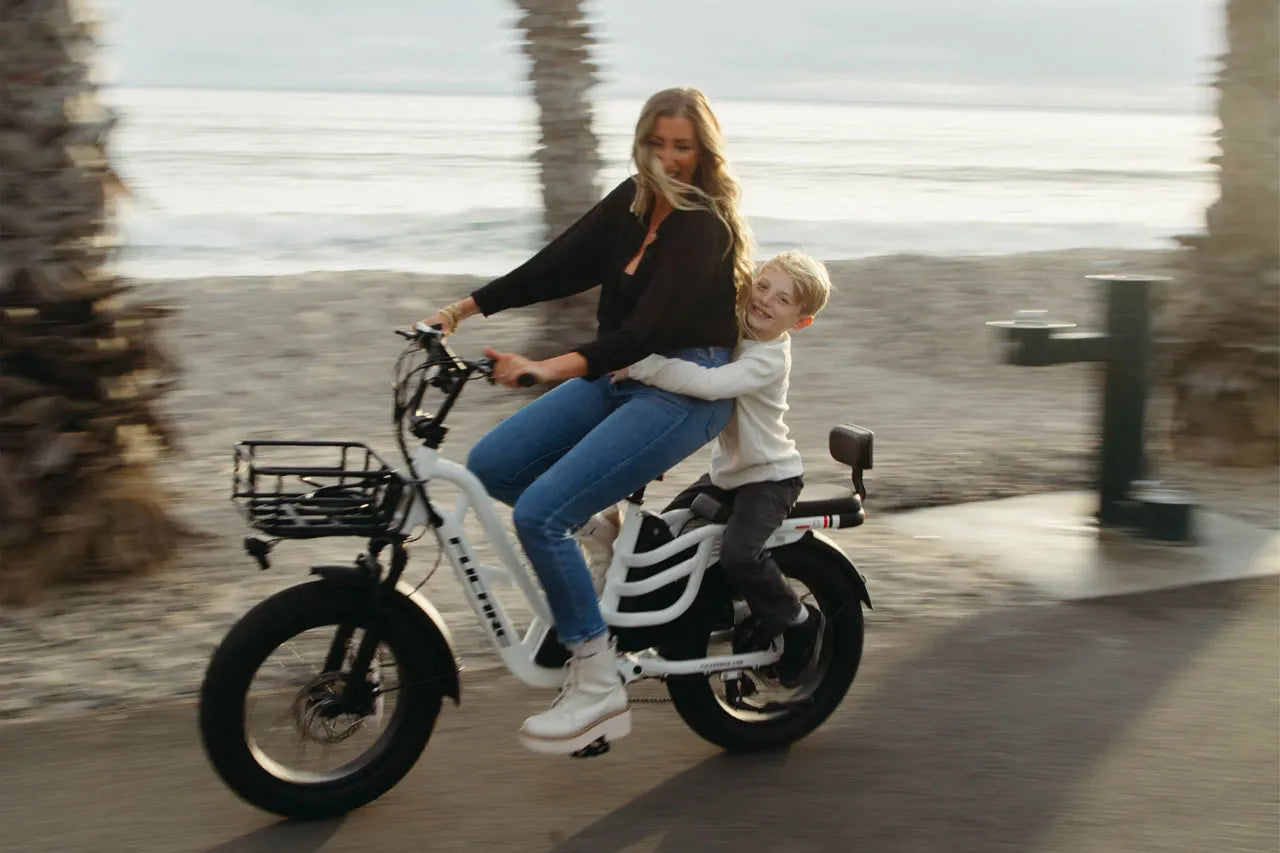
Gift Mom Freedom: Electric Bike for Mother's Day






